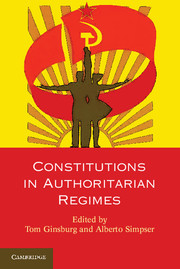Book contents
- Frontmatter
- Contents
- List of Contributors
- 1 Introduction
- Part I The Category
- Part II Constitutional Design in Authoritarian Regimes
- Part III Contents of Authoritarian Constitutions
- 7 The Content of Authoritarian Constitutions
- 8 Constitutional Variation among Strains of Authoritarianism
- Part IV Consequences of Authoritarian Constitutions
- Index
- References
8 - Constitutional Variation among Strains of Authoritarianism
Published online by Cambridge University Press: 05 June 2014
- Frontmatter
- Contents
- List of Contributors
- 1 Introduction
- Part I The Category
- Part II Constitutional Design in Authoritarian Regimes
- Part III Contents of Authoritarian Constitutions
- 7 The Content of Authoritarian Constitutions
- 8 Constitutional Variation among Strains of Authoritarianism
- Part IV Consequences of Authoritarian Constitutions
- Index
- References
Summary
INTRODUCTION
Legend has it that Russian Field Marshall Potemkin built the façades of nonexistent villages along the banks of the river Dnieper to impress visiting dignitaries, such as the Empress, with the illusion of prosperity. Some constitutions are the equivalent of Potemkin villages: they neither constrain nor accurately describe the powers of the state but instead exist primarily to present an attractive face to the world (see, e.g., Law and Versteeg 2013; see also Brown 2002: 4, 91–2; Howard 2009: 13; Lane 1996: 122; Law 2010: 382–3; Marcos 2003: 259; Murphy 1993: 8–9, 2007: 14; Nolutshungu 1993: 366; Sakwa 1996: 118; Sartori 1962: 861; Zhang 2010: 952). It is not difficult to see why authoritarian states might choose to adopt sham constitutions. On the one hand, countries that openly defy the values of “world society” (Meyer et al. 1997) by refusing to pay lip service to human rights and democracy invite ostracism from the international community. On the other hand, there are no constitutional enforcement mechanisms at either the domestic or international level to prevent authoritarian states from making empty promises.
Not all authoritarian constitutions, however, can be dismissed as window-dressing. Some are relatively accurate reflections of a country's legal and political institutions, to the point of brutal candor. The Saudi constitution, for example, expressly obligates the media to “employ courteous language” and conform to state regulation, while the first Soviet constitution explicitly committed the state to “deprive individuals and sections of the community of any rights used by them to the detriment of the interests of the Socialist Revolution.” Even an authoritarian regime may have rational reasons for practicing a form of constitutional modesty. Making empty promises can be costly, and an accurate constitution may perform useful functions for the regime. It has been argued, for example, that a constitution can solve coordination problems among members of the regime itself.
- Type
- Chapter
- Information
- Constitutions in Authoritarian Regimes , pp. 165 - 196Publisher: Cambridge University PressPrint publication year: 2013
References
- 7
- Cited by



